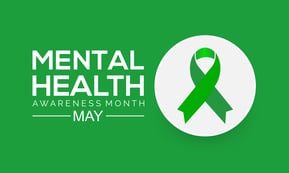
The month of May is a time to raise awareness for mental and behavioral health issues and to reduce the stigma so many people, including those in fire service, experience. Since 1949, mental health organizations like Mental Health America and the National Alliance on Mental Illness have recognized May as Mental Health Awareness Month by reaching out to people across the country and spreading the word through local events and screenings.
An estimated 450 million people around the world currently live with a mental illness. Of those 450 million people, 130 million never seek treatment for a variety of reasons. These numbers continued to climb during the COVID-19 pandemic. Now more than ever, mental health professionals, communities, workplaces, and public health officials are working to break the stigma by talking about mental health and providing resources for anyone to use. This includes CertaSite.
At CertaSite, we take mental health seriously. Through our benefits and wellness programs, we offer an array of resources that can assist employees or their family members in the event of a mental health crisis. We want to break the stigma and, together, we are making progress towards that.
Each year, Mental Health Awareness Month has a theme. This year’s theme reflects on efforts made throughout the pandemic and making sure we are all working together to increase mental health awareness and knowledge.
Making Their Mark in Fire Safety

Throughout the pandemic, people around the globe have faced isolation, turmoil and unrest, and a growing number of Americans struggled with their mental health. One thing we learned from this experience is that we all struggle during challenging times and need support and access to care so we can thrive.
The theme of this year’s Mental Health Awareness Month is Together for Mental Health. Mental health is an incredibly important part of our overall health. It is important that we all join together to advocate for better mental health care and awareness.
Public Progress
Mental health is essential for a person's overall health. Prevention works, treatment is effective, and people who have mental disorders can live full and productive lives. Over the past 20 years, the Substance Abuse and Mental Health Services Administration, others within the Federal Government, the public health community, and the general public have made efforts to increase the importance of understanding both prevention and treatment of mental health problems. These efforts have significantly improved the outlook for those affected by mental illnesses.
There have been many successful efforts that have raised awareness about the importance of mental health and promoted prevention, acceptance, and support, including:
-
Affordable Care Act. By 2016, approximately 11 million of the 30 million Americans who are eligible for health insurance coverage through the Affordable Care Act will have substance abuse and/or mental health service needs.
-
Community Mental Health Services Block Grant. This grant provides financial assistance to states and territories to carry out state plans to offer comprehensive community-based mental health services and evidence-based practices to adults with serious mental illnesses and children with serious emotional disturbances.
-
Mental Health Parity and Addiction Equity Act. In 2008, the Mental Health Parity and Addiction Equity Act eliminated the practice of unequal health treatment and improved access to mental health treatment services through more equitable insurance coverage.
-
Americans with Disabilities Act (ADA). This law “prohibits discrimination against individuals with disabilities in all areas of public life, including jobs, schools, transportation, and all public and private places that are open to the general public.” The ADA defines disability “as a physical or mental impairment that substantially limits one or more major life activities. ADA is divided into five sections, including Title 1 Employment, which gives people with disabilities equal employment opportunities and access to the same benefits available to people without disabilities.
Mental Health and Fire Protection
The mental health stigma impacts almost all industries, and fire service is not exempt. Mental health awareness and resources are critical for firefighters and first responders.
Post-traumatic stress disorder (PTSD) is real in the fire service. Improving mental and behavioral health awareness means understanding the urgent need for PTSD care, as well as treatment for depression and anxiety.
Like most first responders, firefighters are expected to be calm and level-headed. They have long been expected to suppress their emotions with the understanding that only those who have the ability to successfully manage the stress and emotional aspects of the job are cut out for success.
As a result, many firefighters have suppressed their feelings, ultimately leading to consequences for their mental health. According to one study from the International Association of Firefighters, NBC New York and NBC Bay Area, 65 percent of the 7,000 respondents struggle with memories of difficult calls, while 59 percent have had family or relationship problems as a result of their jobs. Substance abuse issues were experienced by 27 percent, while 19 percent have had thoughts of suicide.
Firefighters and first responders should be encouraged to seek treatment at the first sign of a problem. Untreated mental health disorders often worsen over time. Early intervention can lead to a shorter length of symptoms. Quick action is especially important for a complex disorder, such as PTSD, as untreated PTSD can lead to long-term problems.
Because of the “tough it out” mentality amongst firefighters, many fire departments are making changes to break the stigma. Some are hiring full-time psychologists who help firefighters manage their stress levels on the job or at home. The Firefighter Behavioral Health Alliance works closely with fire departments to “raise awareness and improve the understanding of mental health in the fire service.” Their programs focus on breaking the stigma around mental health and giving firefighters the tools and resources needed to identify issues in themselves, their family and friends, and coworkers. The Code Green Campaign is another organization raising mental health awareness by providing educational materials, courses, and resources to firefighters for them to care for themselves and others. Finally, the National Volunteer Fire Council’s Share the Load Program provides additional resources and materials that demonstrate mental health warning signs.
Mental Health Awareness Month gives us a valuable opportunity to celebrate the tremendous strides this nation and globe have made in promoting mental health and increasing the public's knowledge in an effort to break the stigma. But, we must remember that mental health is health. Mental health conditions, like high blood pressure, are treatable medical conditions. People with mental illness can — and do — live normal, very productive, and happy lives. A quick scroll through social media or the news will remind all of us that many successful business owners, athletes, and celebrities live with mental health conditions as more and more are starting to speak out about their personal experiences.
If you or someone you know is living with PTSD, substance addiction, or another mental health condition, please know help is available. The websites below link to some of the most useful resources and helplines available to the public.
Let us keep working toward a world where people are not afraid to seek help for mental health conditions. Together, we can break the stigma.
Mental Health Resources:




